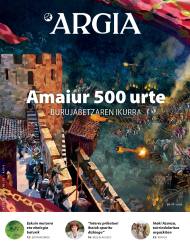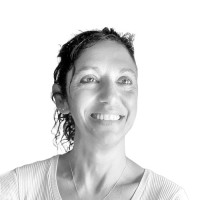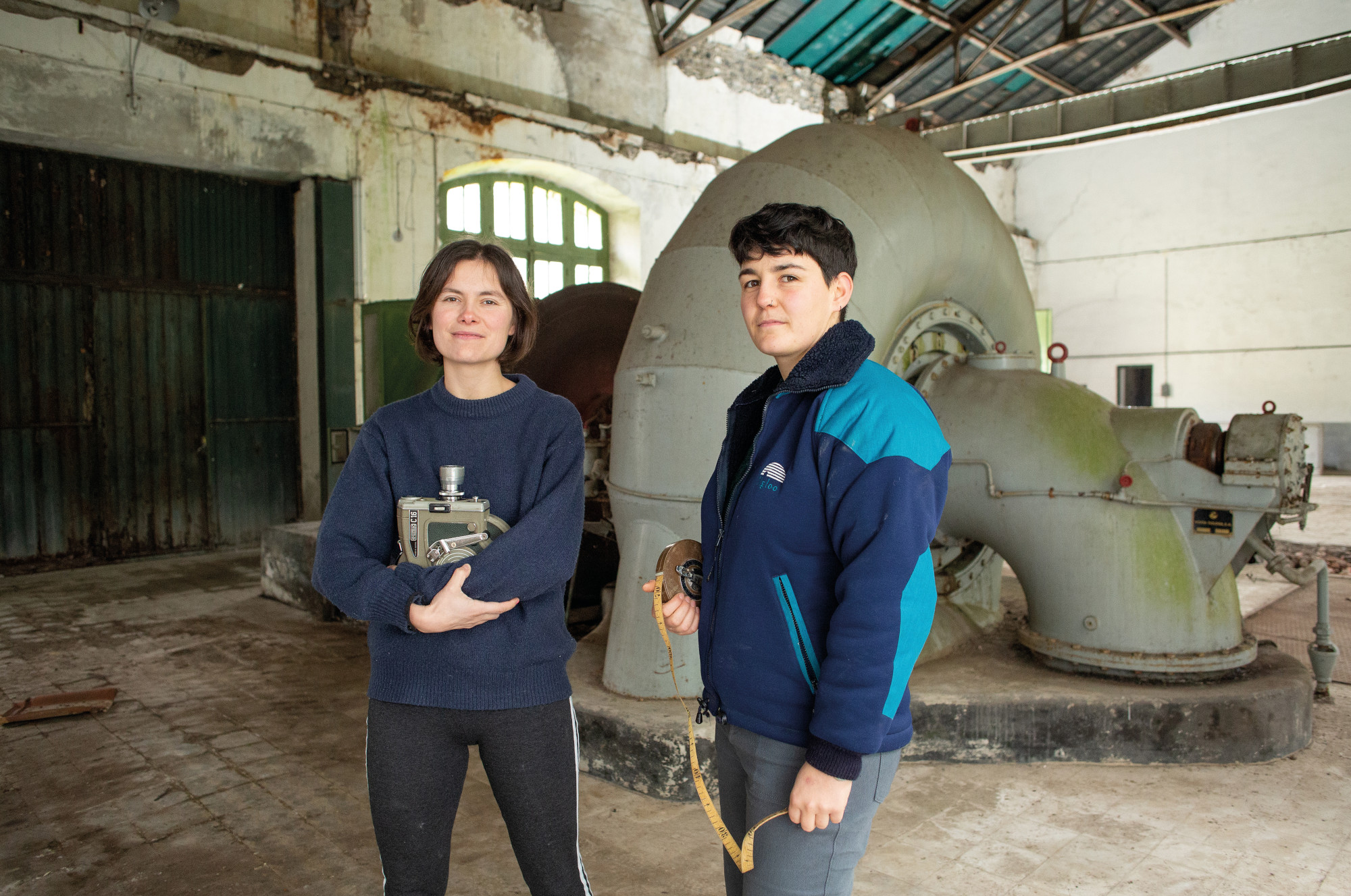"Large dams and giant dams are an indispensable hydromyth for agriculture"
- By Murillo passes the river Aragon and has always wanted to immerse himself in its waters. They called little trout in the village. Driven by water and passion for nature, she has participated in different groups. He now works with Urbizu and together with 13 other environmental groups have launched a high-impact information campaign around the Caparroso beef macro.

Informazio Zientzietan lizentziaduna da Bartzelonako Unibertsitate Autonomoan eta ingurumen aktibista. Ibai kudeaketa iraunkorra eta uraren kudeaketa integratua masterra egina du Zaragozako Unibertsitatean. Fundación Nueva Cultura del Agua-Urbizi taldeko kidea da. Urtetan Iruñerriko Mankomunitatean lan egin du hezitzaile moduan eta gaur egun Euskara Teknikaria da Urrotz, Lizoainibar-Arriasgoiti, Izagaondoa, Longida, Urraulbeiti eta Elon. Tafallan 2019an gertatutako uholdeak zirela-eta argitaratuko Hasta aquí llegó la penúltima riada. Las enseñanzas de Zidacos (Altaffaylla, 2019) [Honaino iritsi zen azken-aurreko uholdea. Zidacos-eko irakaspenak] liburu kolektiboan parte hartu zuen.
At the end of March, the heads of the macro-farms of Caparroso called for fourteen ecological groups to act of reconciliation, including Urbizi. How is the matter?
They say that for making insulting statements and slander we were called fourteen collectives by the court and, of course, we do not accept it. Only the reports issued by the Guardia Foral, the forest guards, the Confederación del Ebro and various entities were collected and presented to the Parliament of Navarra. Arguing that we were harming their image and their business, the company got angry and they have called us to apologize. The company Valle de Odieta has a period of one year to bring a criminal complaint against us and perhaps they will. No one among us is going to go back, but there is also the point of fatigue of some. If you make a complaint against us, I don't know what can happen. We may have to respond to personal heritage, but we have a repeated decision to go to Europe. Nowhere in Europe are such macroines allowed, except in the Spanish State. A stir has to be created, because behind it come many other projects, such as the farm of 23,000 cows they want to make in Noviercas (Soria, Spain). With this livestock model, nothing worthy and good can be done, and they also carry out incredible greenwhasing campaigns saying that they produce bio-milk, bio-fertilizer, circular economy, zero km… using those concepts maliciously, just lie.
Does this project progress in Soria?The
Douro Confederation placed obstacles to it, but then ceded and now has green light. We are promoting unhealthy eating around the world. The coexistence of so many animals poses a risk in their limited space, as well as being cruel. Pests can occur at any time because conditions are not healthy and live as if they were sick, taking antibiotics and other medications along with food.
In China, by the end of 2018 they had to kill half of the animals a pig pest. To supply this market eleven new farms were opened in Europe, but in China the macroines are building very quickly, some huge 12-story farms, making the future of these new European farms very uncertain.
From now on the law has agreed that in Navarre maximum amounts for animals should be fixed. Is that enough?
No. 1,250 animals are still too many and, furthermore, with this announcement, some projects are running and hurried to get permission before the adoption and entry into force of the law.
In Navarre we had the opportunity to strengthen our autonomy and nourishment in sovereignty and to remain firmer in any possible crisis, but in the government they have no intention of hindering the current development model. In the Environmental Department we have Geroa Bai's advisor and they say that they are very green social, but I do not know if the right would also dare to do what they are doing with complete peace of mind.
Around renewables, for example, land and mountains are filled with solar panels and windmills. There are over 50 projects across Navarre. For self-consumption, on the other hand, if you want to put infrastructures at home, you find a lot of obstacles and bureaucracies. They consider us fools.
Governments generally pretend that they are working for the environment, but do not make important decisions. Another example was the conduct of major campaigns to announce the removal of plastic straws from the market. In such a small account they spent a lot of money and time and today we continue to see straws everywhere and, in general, the use of plastic has increased considerably.
What could be done to reduce the use of plastics?
Forcing people and businesses, such as banning smoking in closed places and in many spaces. A good packaging law is essential, with bans and rules above; we citizens cannot do the right thing if we are forced to buy almost all the food wrapped in plastic. Waste management is crazy. We have been led to believe that the use of plastic is more hygienic nico.Eso we have seen it clear with the pandemic. Another problem is poor social mobilization. Young people do not believe anything either. There was a passion for the environment 20-25 years ago, but they've got bored and now they don't get into these issues.
.jpg)
"Rivers are given to powerful electricity companies, large construction and cement companies, industrial agriculture and huge tourism projects"
How does the Caparroso farm affect soil quality?
The influence is enormous. Almost 7,000 cows of excrement and urine are mixed there, filled with medicines and plant protection products, organic waste from the County of Pamplona and organic waste of 49 types from different parts of the State, including sewage sludge and slaughterhouse waste. Digestors mix everything together, and after a bio-metering process, they get gas and solid matter. They say that they use methane for the operation of their machines and use solid waste as fertilizer on land, but it is not a fertilizer because nothing that is extracted cannot be good. This does not favour land. It can serve for plant growth but impoverishes land in the long term. We have quite dead land and with these fertilizers not the enriquecemos.Estit is clear that the Odiet Valley do what they want. They have been fined in communal lands for throwing these digestates out of control or authorization, but they don't care if they have money to pay fines. They receive multiple subsidies and subsidies.
In the region of Pamplona we have been thinking for years that things are doing very well, but that is not the case, especially in waste management. The clearest example is organic waste. Instead of sending it to Caparroso, you could get an ideal manure to pay for all the plots of the area, placing six or seven composting points in the County of Pamplona.
And how does the water of Caparroso affect?The dirty waters
coming out of there are polluting the groundwater, as Greenpeace showed, but they do not want to acknowledge it. In the face of complaints, the foral government says that pollution is diffuse. The presence of nitrates in aquifers is high, although not visible. They do not want to relate to Caparroso's cowboy, but since it was placed it has increased considerably and the problems are obvious: The water they drank in Villafranca no longer complies with quality me
nima.El researcher Pedro Arrojo states that all this is an attack on human rights. In Villafranca they cannot drink water and the only solution given by the government is to take it through the canal of Navarra, even if it is much more expensive.
The problem is not only the expense of bringing water from the outside, but also vulnerability. If something happened in the stream, they would run out of mouth. What they are doing is very serious. The recovery of groundwater quality is very difficult because it costs much more than surface water.
When talking about rivers, the hydrogeologist at the University of Zaragoza, Javier Martínez Gil, states that the rivers are like the plots of land and that it is necessary to maintain their good condition. He uses the concept of “fluviopyelicity” or “fluviopyelicity” to indicate that our health, happiness, tranquility, joy, sweet relationships... are related to rivers. It also talks about the “hydromyths”, that is, the misconceptions surrounding the water: that the water that reaches the sea is lost, that more reservoirs are needed, that the rivers are dredged…
Is it a hydromyth, for example, that in the Ribera there is little water and that is why it has to be carried by the north of Navarra?
Yes. Or that giant swamps are indispensable for agriculture.
"A paradigm shift is needed: understanding that water is not a resource for the economy, it is a heritage of all, so we must demand and promote fair management"
To say that there is little water in the center of Navarre and in the Ribera is silly because the largest rivers pass through: Ebro, Aragón, Ega, Arga, Zidakos, Alhama...
Droughts and floods are common and we must learn how to manage them. However, irrigation and hydroelectric plants have been given the right to extract the desired water, and if excessive extraction occurs when the inputs are scarce, it is normal that there is a shortage of water. Keeping rivers in their natural state to the fullest is keeping the golden egg hen alive.
In Navarre, conflicts over water have long come. In all the struggles of Urbizi, we insist on the need for a new, participatory, transparent and just governance. A paradigm shift is needed: to understand that water is a common heritage rather than a resource for the economy and, therefore, to demand and promote fair management.
Is agriculture changing a lot in Navarre?
Yes. If we look at what has happened in the last 50 years, the agricultural model that has spread is absolutely debatable. In 1985, there were 65,000 hectares of irrigated crops in Navarre, so many families lived. They have now doubled and increased, although the number of farmers is falling considerably. The Navarre canal project is continuing, because although it is a bad business, we will all have to pay for many years.
The momentum of agriculture in the extension of irrigation areas in the twentieth century cannot be denied, but it is clear that in practice rivers have been given away to private interests. Agriculture is currently in very few hands. Many have had to transfer their land to large farms because of their small plots and now, in order to access all the aids and rights existing in the irrigation system, they need a minimum area of five hectare reas.Con these conditions are impossible for many young people to enter agriculture or continue with family land. There is a terrible gap.
In these large farms, in many cases, a single head manages the plots of eleven small owners. They use highly technical plans, immense machinery, few jobs and poor jobs, and many poisonous plant protection products. The aim is to achieve the highest production and highest yield, but things are not easy: fuel prices, fertilizers... Most of the production is concentrated on crops intended for animal feed: wheat, maize, barley... Not for the healthy food we need humans, that is, ecological.
The poor farmers who have recently joined are mainly engaged in organic production, because there are far more humane measures there, but they, for example, in most cases do not have access to water from the Canal de Navarra.
.jpg)
"In the Environmental Department we have Geroa Bai's counselor and they say they're very social green, but I don't know if the right would dare to do what they're doing with complete peace of mind."
What is the Navarre canal?
The second phase now begins to bring the waters of Itoiz to the Ribera. The project consists of transporting water through two large pipelines instead of an open channel. This phase justifies the need for water supply in several localities of the Ribera, and it is true, but what they do not say is that they have allowed to negligently contaminate the wells and springs that were used for water collection and to deteriorate the previous infrastructures, in the belief that the stream would arrive.
Do rivers need to be cleaned to minimize flooding?
Although people believe otherwise, cleaning up the boat is not beneficial when flooding occurs. If water has no obstacles to plants and shrubs, it reaches tremendous speed. If we give the river the opportunity to open it, it will raise some grounds and lose strength to return freely to its path.
What happened in Tafalla in July 2019 on the Zidakos River made it clear that the problem is not the cleaning of rivers, but the occupation of the bank and the ordination of the territory in general. The Zidakos basin is very wide and fell a lot of water in a very short time. It wasn't raining for a long time, the surface clay became a raincoat, and also water found more rigid barriers than ever before. The vegetable hedges or hedges that were among the orchards are now cement walls; those that were houses are now pieces of house; where before there was land, there are now tile and cement floors that do not allow water to be absorbed… The domino effect occurred. The water came strong from Orbaibar, taking increasing speed. He was dragging everything, even great tractors and throwing materials like shrapnel.
People immediately complained that the Ebro Hydrographic Confederation cleanses the rivers, but the opposite must be done: let the river organize itself. In the confederation, despite knowing that this type of cleaning, dredging, is not good, they are heeded; besides, instead of breaking down the existing obstacles in the course, they were rebuilt. In the opinion of many groups such as Urbizi, we must remove the trash from the river bank, but also the buildings and infrastructures to the maximum, because otherwise in the next floods the same will happen to us.
With the Zabalduz caravan in the city of Bihac in Bosnia Herzegovina, activist Nihad Suljic explained to us that the Drina River is the largest tomb in the Balkans. In order not to be forgotten, he is responsible for identifying the bodies that are found and for giving them... [+]






















